torque JEEP WRANGLER UNLIMITED 2020 Owner handbook (in English)
[x] Cancel search | Manufacturer: JEEP, Model Year: 2020, Model line: WRANGLER UNLIMITED, Model: JEEP WRANGLER UNLIMITED 2020Pages: 330, PDF Size: 9.16 MB
Page 10 of 330
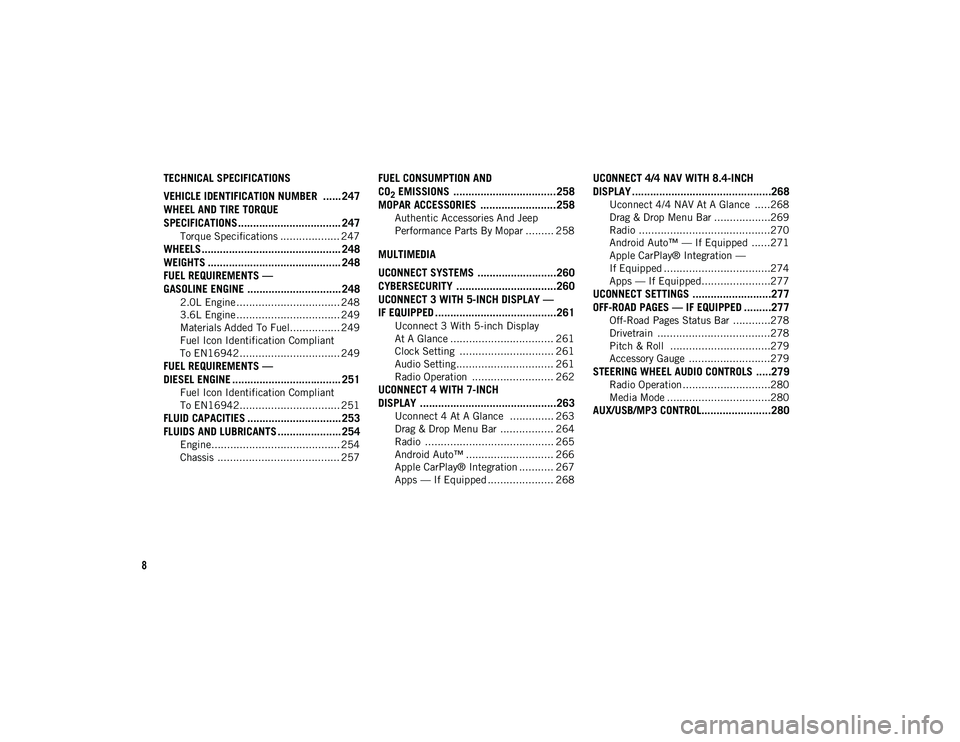
8
TECHNICAL SPECIFICATIONS
VEHICLE IDENTIFICATION NUMBER ...... 247
WHEEL AND TIRE TORQUE
SPECIFICATIONS .................................. 247
Torque Specifications ................... 247
WHEELS .............................................. 248
WEIGHTS ............................................ 248FUEL REQUIREMENTS —
GASOLINE ENGINE ............................... 248
2.0L Engine ................................. 248
3.6L Engine ................................. 249
Materials Added To Fuel................ 249
Fuel Icon Identification Compliant
To EN16942................................ 249
FUEL REQUIREMENTS —
DIESEL ENGINE .................................... 251
Fuel Icon Identification Compliant
To EN16942................................ 251
FLUID CAPACITIES ............................... 253 FLUIDS AND LUBRICANTS ..................... 254
Engine......................................... 254
Chassis ....................................... 257
FUEL CONSUMPTION AND
CO
2 EMISSIONS ..................................258
MOPAR ACCESSORIES .........................258
Authentic Accessories And Jeep
Performance Parts By Mopar ......... 258
MULTIMEDIA
UCONNECT SYSTEMS ..........................260
CYBERSECURITY .................................260
UCONNECT 3 WITH 5-INCH DISPLAY —
IF EQUIPPED ........................................261
Uconnect 3 With 5-inch Display
At A Glance ................................. 261 Clock Setting .............................. 261
Audio Setting............................... 261
Radio Operation .......................... 262
UCONNECT 4 WITH 7-INCH
DISPLAY .............................................263
Uconnect 4 At A Glance .............. 263
Drag & Drop Menu Bar ................. 264
Radio ......................................... 265
Android Auto™ ............................ 266
Apple CarPlay® Integration ........... 267
Apps — If Equipped ..................... 268
UCONNECT 4/4 NAV WITH 8.4-INCH
DISPLAY ..............................................268
Uconnect 4/4 NAV At A Glance .....268
Drag & Drop Menu Bar ..................269
Radio ..........................................270
Android Auto™ — If Equipped ......271
Apple CarPlay® Integration —
If Equipped ..................................274 Apps — If Equipped......................277
UCONNECT SETTINGS ..........................277OFF-ROAD PAGES — IF EQUIPPED .........277
Off-Road Pages Status Bar ............278
Drivetrain ....................................278
Pitch & Roll ................................279
Accessory Gauge ..........................279
STEERING WHEEL AUDIO CONTROLS .....279
Radio Operation ............................280
Media Mode .................................280
AUX/USB/MP3 CONTROL.......................280
2020_JEEP_JL_WRANGLER_UG_RHD_UK.book Page 8
Page 23 of 330
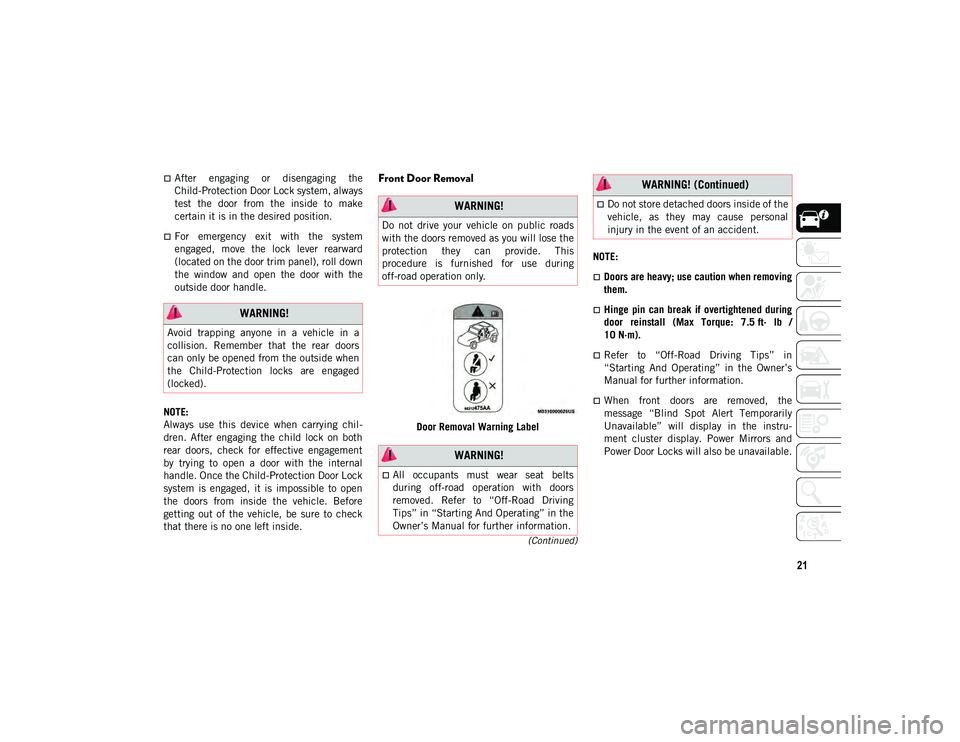
21
(Continued)
After engaging or disengaging the
Child-Protection Door Lock system, always
test the door from the inside to make
certain it is in the desired position.
For emergency exit with the system
engaged, move the lock lever rearward
(located on the door trim panel), roll down
the window and open the door with the
outside door handle.
NOTE:
Always use this device when carrying chil -
dren. After engaging the child lock on both
rear doors, check for effective engagement
by trying to open a door with the internal
handle. Once the Child-Protection Door Lock
system is engaged, it is impossible to open
the doors from inside the vehicle. Before
getting out of the vehicle, be sure to check
that there is no one left inside.
Front Door Removal
Door Removal Warning Label NOTE:
Doors are heavy; use caution when removing
them.
Hinge pin can break if overtightened during
door reinstall (Max Torque: 7.5 ft· lb /
10 N·m).
Refer to “Off-Road Driving Tips” in
“Starting And Operating” in the Owner’s
Manual for further information.
When front doors are removed, the
message “Blind Spot Alert Temporarily
Unavailable” will display in the instru
-
ment cluster display. Power Mirrors and
Power Door Locks will also be unavailable.
WARNING!
Avoid trapping anyone in a vehicle in a
collision. Remember that the rear doors
can only be opened from the outside when
the Child-Protection locks are engaged
(locked).
WARNING!
Do not drive your vehicle on public roads
with the doors removed as you will lose the
protection they can provide. This
procedure is furnished for use during
off-road operation only.
WARNING!
All occupants must wear seat belts
during off-road operation with doors
removed. Refer to “Off-Road Driving
Tips” in “Starting And Operating” in the
Owner’s Manual for further information.
Do not store detached doors inside of the
vehicle, as they may cause personal
injury in the event of an accident.
WARNING! (Continued)
2020_JEEP_JL_WRANGLER_UG_RHD_UK.book Page 21
Page 25 of 330
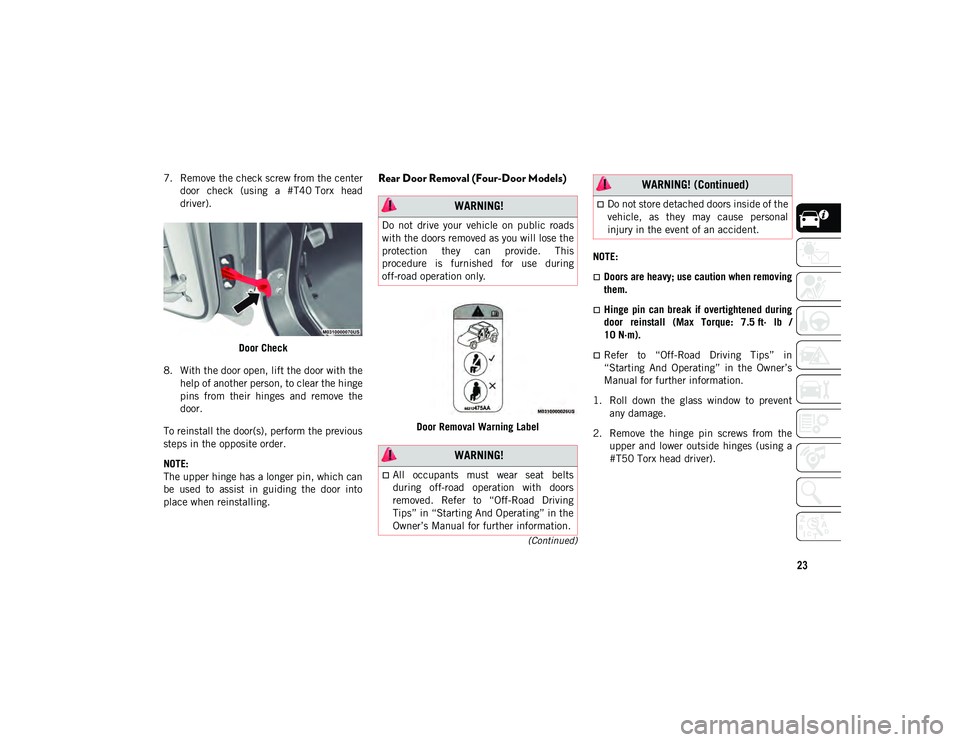
23
(Continued)
7. Remove the check screw from the centerdoor check (using a #T40 Torx head
driver).
Door Check
8. With the door open, lift the door with the help of another person, to clear the hinge
pins from their hinges and remove the
door.
To reinstall the door(s), perform the previous
steps in the opposite order.
NOTE:
The upper hinge has a longer pin, which can
be used to assist in guiding the door into
place when reinstalling.Rear Door Removal (Four-Door Models)
Door Removal Warning Label NOTE:
Doors are heavy; use caution when removing
them.
Hinge pin can break if overtightened during
door reinstall (Max Torque: 7.5 ft· lb /
10 N·m).
Refer to “Off-Road Driving Tips” in
“Starting And Operating” in the Owner’s
Manual for further information.
1. Roll down the glass window to prevent any damage.
2. Remove the hinge pin screws from the upper and lower outside hinges (using a
#T50 Torx head driver).
WARNING!
Do not drive your vehicle on public roads
with the doors removed as you will lose the
protection they can provide. This
procedure is furnished for use during
off-road operation only.
WARNING!
All occupants must wear seat belts
during off-road operation with doors
removed. Refer to “Off-Road Driving
Tips” in “Starting And Operating” in the
Owner’s Manual for further information.
Do not store detached doors inside of the
vehicle, as they may cause personal
injury in the event of an accident.
WARNING! (Continued)
2020_JEEP_JL_WRANGLER_UG_RHD_UK.book Page 23
Page 74 of 330
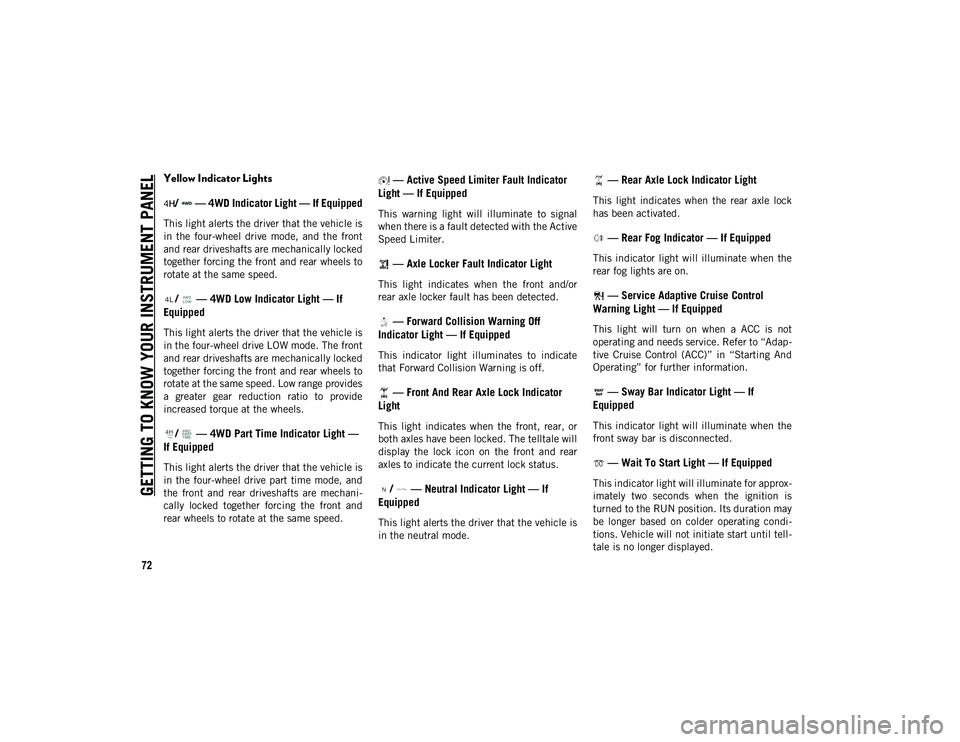
GETTING TO KNOW YOUR INSTRUMENT PANEL
72
Yellow Indicator Lights/ — 4WD Indicator Light — If Equipped
This light alerts the driver that the vehicle is
in the four-wheel drive mode, and the front
and rear driveshafts are mechanically locked
together forcing the front and rear wheels to
rotate at the same speed.
/ — 4WD Low Indicator Light — If
Equipped
This light alerts the driver that the vehicle is
in the four-wheel drive LOW mode. The front
and rear driveshafts are mechanically locked
together forcing the front and rear wheels to
rotate at the same speed. Low range provides
a greater gear reduction ratio to provide
increased torque at the wheels.
/ — 4WD Part Time Indicator Light —
If Equipped
This light alerts the driver that the vehicle is
in the four-wheel drive part time mode, and
the front and rear driveshafts are mechani -
cally locked together forcing the front and
rear wheels to rotate at the same speed.
— Active Speed Limiter Fault Indicator
Light — If Equipped
This warning light will illuminate to signal
when there is a fault detected with the Active
Speed Limiter.
— Axle Locker Fault Indicator Light
This light indicates when the front and/or
rear axle locker fault has been detected.
— Forward Collision Warning Off
Indicator Light — If Equipped
This indicator light illuminates to indicate
that Forward Collision Warning is off.
— Front And Rear Axle Lock Indicator
Light
This light indicates when the front, rear, or
both axles have been locked. The telltale will
display the lock icon on the front and rear
axles to indicate the current lock status.
/ — Neutral Indicator Light — If
Equipped
This light alerts the driver that the vehicle is
in the neutral mode.
— Rear Axle Lock Indicator Light
This light indicates when the rear axle lock
has been activated.
— Rear Fog Indicator — If Equipped
This indicator light will illuminate when the
rear fog lights are on.
— Service Adaptive Cruise Control
Warning Light — If Equipped
This light will turn on when a ACC is not
operating and needs service. Refer to “Adap -
tive Cruise Control (ACC)” in “Starting And
Operating” for further information.
— Sway Bar Indicator Light — If
Equipped
This indicator light will illuminate when the
front sway bar is disconnected.
— Wait To Start Light — If Equipped
This indicator light will illuminate for approx -
imately two seconds when the ignition is
turned to the RUN position. Its duration may
be longer based on colder operating condi -
tions. Vehicle will not initiate start until tell -
tale is no longer displayed.
2020_JEEP_JL_WRANGLER_UG_RHD_UK.book Page 72
Page 82 of 330
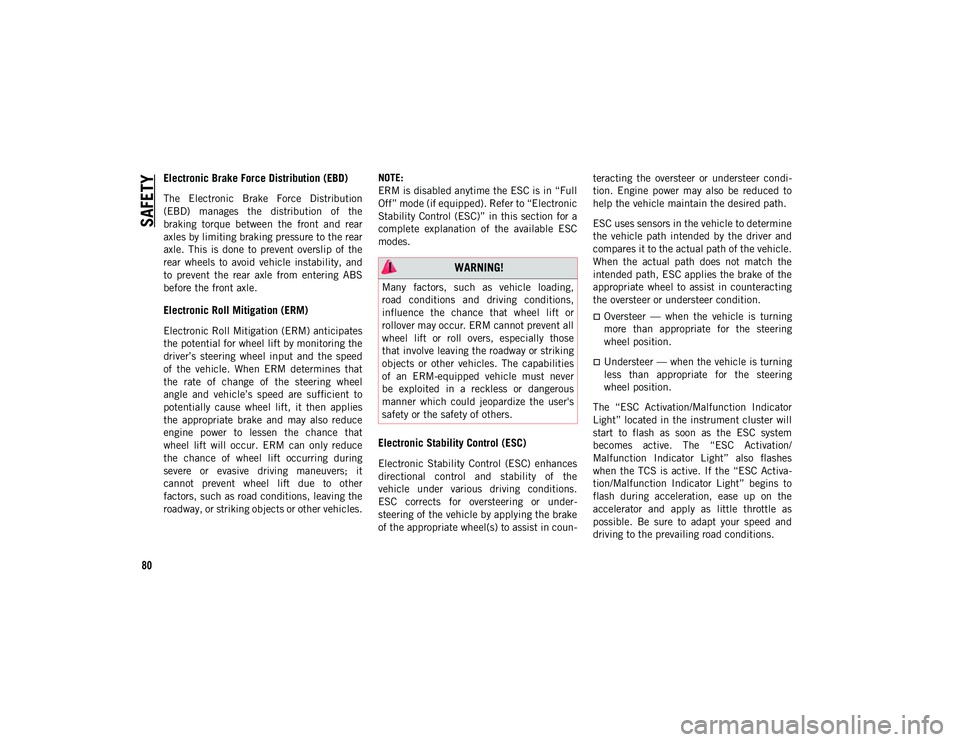
SAFETY
80
Electronic Brake Force Distribution (EBD)
The Electronic Brake Force Distribution
(EBD) manages the distribution of the
braking torque between the front and rear
axles by limiting braking pressure to the rear
axle. This is done to prevent overslip of the
rear wheels to avoid vehicle instability, and
to prevent the rear axle from entering ABS
before the front axle.
Electronic Roll Mitigation (ERM)
Electronic Roll Mitigation (ERM) anticipates
the potential for wheel lift by monitoring the
driver’s steering wheel input and the speed
of the vehicle. When ERM determines that
the rate of change of the steering wheel
angle and vehicle’s speed are sufficient to
potentially cause wheel lift, it then applies
the appropriate brake and may also reduce
engine power to lessen the chance that
wheel lift will occur. ERM can only reduce
the chance of wheel lift occurring during
severe or evasive driving maneuvers; it
cannot prevent wheel lift due to other
factors, such as road conditions, leaving the
roadway, or striking objects or other vehicles.NOTE:
ERM is disabled anytime the ESC is in “Full
Off” mode (if equipped). Refer to “Electronic
Stability Control (ESC)” in this section for a
complete explanation of the available ESC
modes.
Electronic Stability Control (ESC)
Electronic Stability Control (ESC) enhances
directional control and stability of the
vehicle under various driving conditions.
ESC corrects for oversteering or under
-
steering of the vehicle by applying the brake
of the appropriate wheel(s) to assist in coun -teracting the oversteer or understeer condi
-
tion. Engine power may also be reduced to
help the vehicle maintain the desired path.
ESC uses sensors in the vehicle to determine
the vehicle path intended by the driver and
compares it to the actual path of the vehicle.
When the actual path does not match the
intended path, ESC applies the brake of the
appropriate wheel to assist in counteracting
the oversteer or understeer condition.
Oversteer — when the vehicle is turning
more than appropriate for the steering
wheel position.
Understeer — when the vehicle is turning
less than appropriate for the steering
wheel position.
The “ESC Activation/Malfunction Indicator
Light” located in the instrument cluster will
start to flash as soon as the ESC system
becomes active. The “ESC Activation/
Malfunction Indicator Light” also flashes
when the TCS is active. If the “ESC Activa -
tion/Malfunction Indicator Light” begins to
flash during acceleration, ease up on the
accelerator and apply as little throttle as
possible. Be sure to adapt your speed and
driving to the prevailing road conditions.
WARNING!
Many factors, such as vehicle loading,
road conditions and driving conditions,
influence the chance that wheel lift or
rollover may occur. ERM cannot prevent all
wheel lift or roll overs, especially those
that involve leaving the roadway or striking
objects or other vehicles. The capabilities
of an ERM-equipped vehicle must never
be exploited in a reckless or dangerous
manner which could jeopardize the user's
safety or the safety of others.
2020_JEEP_JL_WRANGLER_UG_RHD_UK.book Page 80
Page 84 of 330
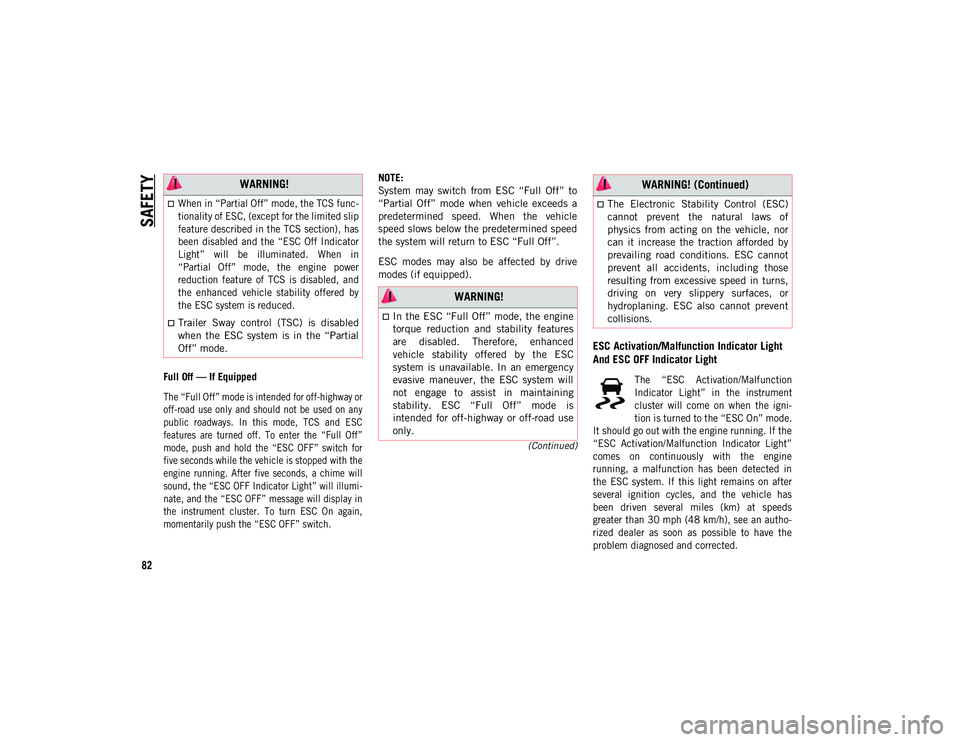
SAFETY
82
(Continued)
Full Off — If Equipped
The “Full Off” mode is intended for off-highway or
off-road use only and should not be used on any
public roadways. In this mode, TCS and ESC
features are turned off. To enter the “Full Off”
mode, push and hold the “ESC OFF” switch for
five seconds while the vehicle is stopped with the
engine running. After five seconds, a chime will
sound, the “ESC OFF Indicator Light” will illumi-
nate, and the “ESC OFF” message will display in
the instrument cluster. To turn ESC On again,
momentarily push the “ESC OFF” switch.
NOTE:
System may switch from ESC “Full Off” to
“Partial Off” mode when vehicle exceeds a
predetermined speed. When the vehicle
speed slows below the predetermined speed
the system will return to ESC “Full Off”.
ESC modes may also be affected by drive
modes (if equipped).
ESC Activation/Malfunction Indicator Light
And ESC OFF Indicator Light
The “ESC Activation/Malfunction
Indicator Light” in the instrument
cluster will come on when the igni
-
tion is turned to the “ESC On” mode.
It should go out with the engine running. If the
“ESC Activation/Malfunction Indicator Light”
comes on continuously with the engine
running, a malfunction has been detected in
the ESC system. If this light remains on after
several ignition cycles, and the vehicle has
been driven several miles (km) at speeds
greater than 30 mph (48 km/h), see an autho -
rized dealer as soon as possible to have the
problem diagnosed and corrected.
WARNING!
When in “Partial Off” mode, the TCS func -
tionality of ESC, (except for the limited slip
feature described in the TCS section), has
been disabled and the “ESC Off Indicator
Light” will be illuminated. When in
“Partial Off” mode, the engine power
reduction feature of TCS is disabled, and
the enhanced vehicle stability offered by
the ESC system is reduced.
Trailer Sway control (TSC) is disabled
when the ESC system is in the “Partial
Off” mode.
WARNING!
In the ESC “Full Off” mode, the engine
torque reduction and stability features
are disabled. Therefore, enhanced
vehicle stability offered by the ESC
system is unavailable. In an emergency
evasive maneuver, the ESC system will
not engage to assist in maintaining
stability. ESC “Full Off” mode is
intended for off-highway or off-road use
only.
The Electronic Stability Control (ESC)
cannot prevent the natural laws of
physics from acting on the vehicle, nor
can it increase the traction afforded by
prevailing road conditions. ESC cannot
prevent all accidents, including those
resulting from excessive speed in turns,
driving on very slippery surfaces, or
hydroplaning. ESC also cannot prevent
collisions.
WARNING! (Continued)
2020_JEEP_JL_WRANGLER_UG_RHD_UK.book Page 82
Page 89 of 330
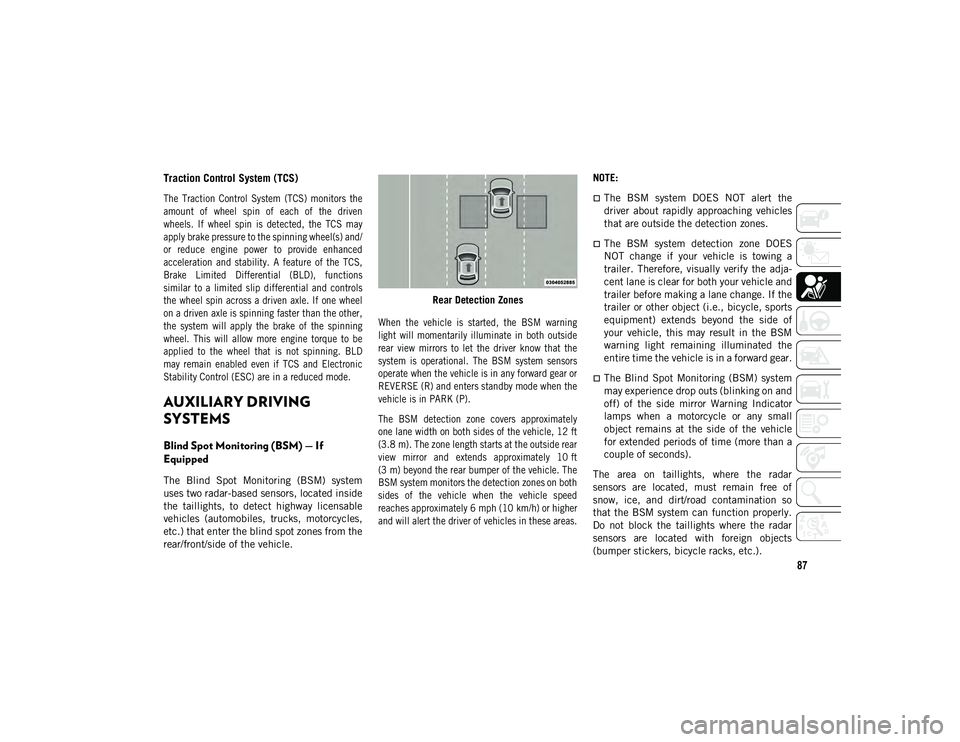
87
Traction Control System (TCS)
The Traction Control System (TCS) monitors the
amount of wheel spin of each of the driven
wheels. If wheel spin is detected, the TCS may
apply brake pressure to the spinning wheel(s) and/
or reduce engine power to provide enhanced
acceleration and stability. A feature of the TCS,
Brake Limited Differential (BLD), functions
similar to a limited slip differential and controls
the wheel spin across a driven axle. If one wheel
on a driven axle is spinning faster than the other,
the system will apply the brake of the spinning
wheel. This will allow more engine torque to be
applied to the wheel that is not spinning. BLD
may remain enabled even if TCS and Electronic
Stability Control (ESC) are in a reduced mode.
AUXILIARY DRIVING
SYSTEMS
Blind Spot Monitoring (BSM) — If
Equipped
The Blind Spot Monitoring (BSM) system
uses two radar-based sensors, located inside
the taillights, to detect highway licensable
vehicles (automobiles, trucks, motorcycles,
etc.) that enter the blind spot zones from the
rear/front/side of the vehicle.Rear Detection Zones
When the vehicle is started, the BSM warning
light will momentarily illuminate in both outside
rear view mirrors to let the driver know that the
system is operational. The BSM system sensors
operate when the vehicle is in any forward gear or
REVERSE (R) and enters standby mode when the
vehicle is in PARK (P).
The BSM detection zone covers approximately
one lane width on both sides of the vehicle, 12 ft
(3.8 m). The zone length starts at the outside rear
view mirror and extends approximately 10 ft
(3 m) beyond the rear bumper of the vehicle. The
BSM system monitors the detection zones on both
sides of the vehicle when the vehicle speed
reaches approximately 6 mph (10 km/h) or higher and will alert the driver of vehicles in these areas.
NOTE:
The BSM system DOES NOT alert the
driver about rapidly approaching vehicles
that are outside the detection zones.
The BSM system detection zone DOES
NOT change if your vehicle is towing a
trailer. Therefore, visually verify the adja-
cent lane is clear for both your vehicle and
trailer before making a lane change. If the
trailer or other object (i.e., bicycle, sports
equipment) extends beyond the side of
your vehicle, this may result in the BSM
warning light remaining illuminated the
entire time the vehicle is in a forward gear.
The Blind Spot Monitoring (BSM) system
may experience drop outs (blinking on and
off) of the side mirror Warning Indicator
lamps when a motorcycle or any small
object remains at the side of the vehicle
for extended periods of time (more than a
couple of seconds).
The area on taillights, where the radar
sensors are located, must remain free of
snow, ice, and dirt/road contamination so
that the BSM system can function properly.
Do not block the taillights where the radar
sensors are located with foreign objects
(bumper stickers, bicycle racks, etc.).
2020_JEEP_JL_WRANGLER_UG_RHD_UK.book Page 87
Page 149 of 330
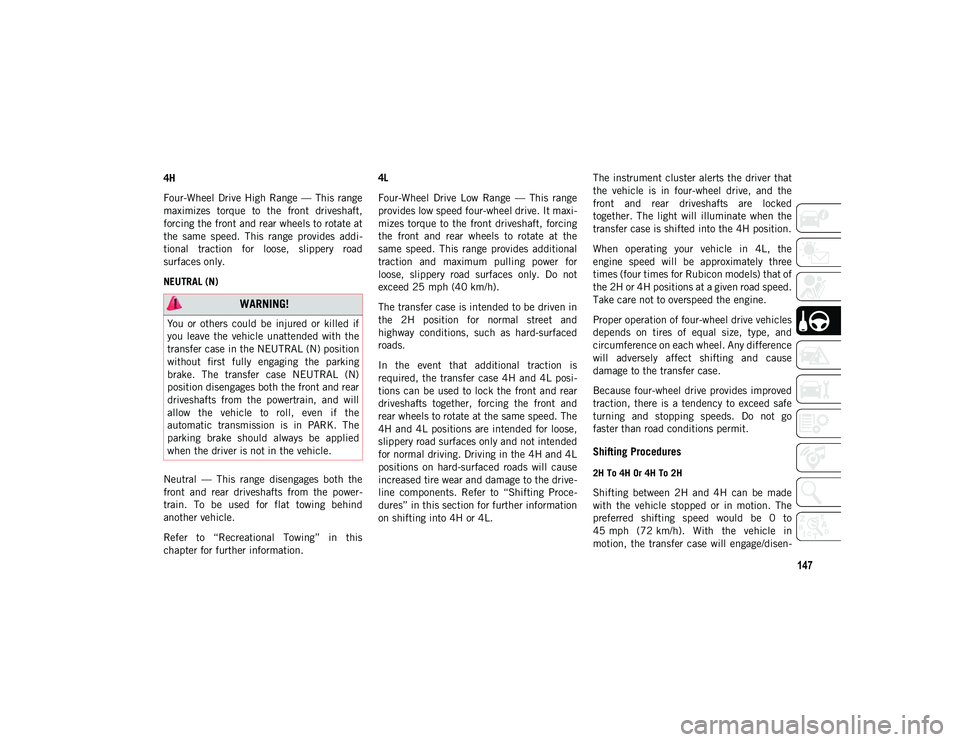
147
4H
Four-Wheel Drive High Range — This range
maximizes torque to the front driveshaft,
forcing the front and rear wheels to rotate at
the same speed. This range provides addi-
tional traction for loose, slippery road
surfaces only.
NEUTRAL (N)
Neutral — This range disengages both the
front and rear driveshafts from the power -
train. To be used for flat towing behind
another vehicle.
Refer to “Recreational Towing” in this
chapter for further information. 4L
Four-Wheel Drive Low Range — This range
provides low speed four-wheel drive. It maxi
-
mizes torque to the front driveshaft, forcing
the front and rear wheels to rotate at the
same speed. This range provides additional
traction and maximum pulling power for
loose, slippery road surfaces only. Do not
exceed 25 mph (40 km/h).
The transfer case is intended to be driven in
the 2H position for normal street and
highway conditions, such as hard-surfaced
roads.
In the event that additional traction is
required, the transfer case 4H and 4L posi -
tions can be used to lock the front and rear
driveshafts together, forcing the front and
rear wheels to rotate at the same speed. The
4H and 4L positions are intended for loose,
slippery road surfaces only and not intended
for normal driving. Driving in the 4H and 4L
positions on hard-surfaced roads will cause
increased tire wear and damage to the drive -
line components. Refer to “Shifting Proce -
dures” in this section for further information
on shifting into 4H or 4L. The instrument cluster alerts the driver that
the vehicle is in four-wheel drive, and the
front and rear driveshafts are locked
together. The light will illuminate when the
transfer case is shifted into the 4H position.
When operating your vehicle in 4L, the
engine speed will be approximately three
times (four times for Rubicon models) that of
the 2H or 4H positions at a given road speed.
Take care not to overspeed the engine.
Proper operation of four-wheel drive vehicles
depends on tires of equal size, type, and
circumference on each wheel. Any difference
will adversely affect shifting and cause
damage to the transfer case.
Because four-wheel drive provides improved
traction, there is a tendency to exceed safe
turning and stopping speeds. Do not go
faster than road conditions permit.
Shifting Procedures
2H To 4H Or 4H To 2H
Shifting between 2H and 4H can be made
with the vehicle stopped or in motion. The
preferred shifting speed would be 0 to
45 mph (72 km/h). With the vehicle in
motion, the transfer case will engage/disen
-
WARNING!
You or others could be injured or killed if
you leave the vehicle unattended with the
transfer case in the NEUTRAL (N) position
without first fully engaging the parking
brake. The transfer case NEUTRAL (N)
position disengages both the front and rear
driveshafts from the powertrain, and will
allow the vehicle to roll, even if the
automatic transmission is in PARK. The
parking brake should always be applied
when the driver is not in the vehicle.
2020_JEEP_JL_WRANGLER_UG_RHD_UK.book Page 147
Page 151 of 330
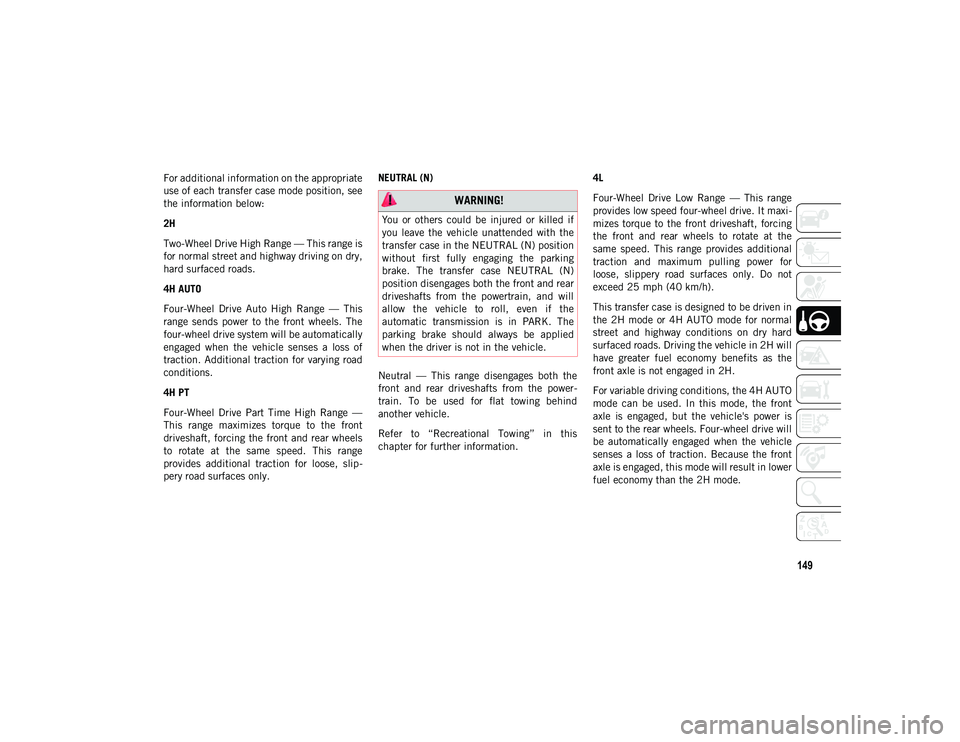
149
For additional information on the appropriate
use of each transfer case mode position, see
the information below:
2H
Two-Wheel Drive High Range — This range is
for normal street and highway driving on dry,
hard surfaced roads.
4H AUTO
Four-Wheel Drive Auto High Range — This
range sends power to the front wheels. The
four-wheel drive system will be automatically
engaged when the vehicle senses a loss of
traction. Additional traction for varying road
conditions.
4H PT
Four-Wheel Drive Part Time High Range —
This range maximizes torque to the front
driveshaft, forcing the front and rear wheels
to rotate at the same speed. This range
provides additional traction for loose, slip-
pery road surfaces only. NEUTRAL (N)
Neutral — This range disengages both the
front and rear driveshafts from the power
-
train. To be used for flat towing behind
another vehicle.
Refer to “Recreational Towing” in this
chapter for further information. 4L
Four-Wheel Drive Low Range — This range
provides low speed four-wheel drive. It maxi
-
mizes torque to the front driveshaft, forcing
the front and rear wheels to rotate at the
same speed. This range provides additional
traction and maximum pulling power for
loose, slippery road surfaces only. Do not
exceed 25 mph (40 km/h).
This transfer case is designed to be driven in
the 2H mode or 4H AUTO mode for normal
street and highway conditions on dry hard
surfaced roads. Driving the vehicle in 2H will
have greater fuel economy benefits as the
front axle is not engaged in 2H.
For variable driving conditions, the 4H AUTO
mode can be used. In this mode, the front
axle is engaged, but the vehicle's power is
sent to the rear wheels. Four-wheel drive will
be automatically engaged when the vehicle
senses a loss of traction. Because the front
axle is engaged, this mode will result in lower
fuel economy than the 2H mode.
WARNING!
You or others could be injured or killed if
you leave the vehicle unattended with the
transfer case in the NEUTRAL (N) position
without first fully engaging the parking
brake. The transfer case NEUTRAL (N)
position disengages both the front and rear
driveshafts from the powertrain, and will
allow the vehicle to roll, even if the
automatic transmission is in PARK. The
parking brake should always be applied
when the driver is not in the vehicle.
2020_JEEP_JL_WRANGLER_UG_RHD_UK.book Page 149
Page 153 of 330
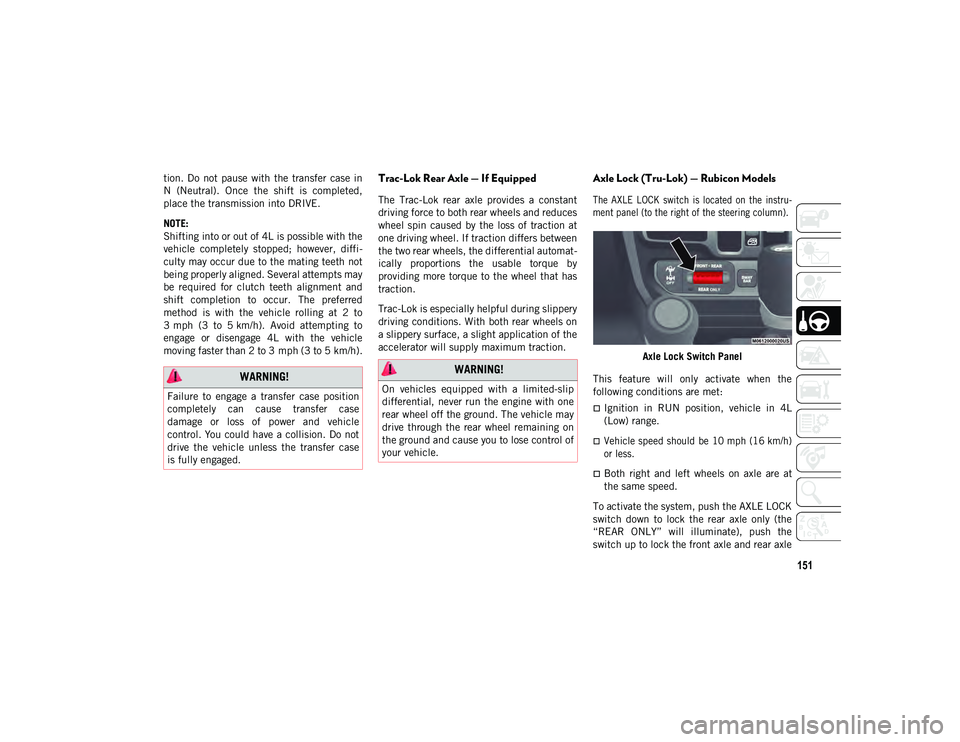
151
tion. Do not pause with the transfer case in
N (Neutral). Once the shift is completed,
place the transmission into DRIVE.
NOTE:
Shifting into or out of 4L is possible with the
vehicle completely stopped; however, diffi-
culty may occur due to the mating teeth not
being properly aligned. Several attempts may
be required for clutch teeth alignment and
shift completion to occur. The preferred
method is with the vehicle rolling at 2 to
3 mph (3 to 5 km/h). Avoid attempting to
engage or disengage 4L with the vehicle
moving faster than 2 to 3 mph (3 to 5 km/h).Trac-Lok Rear Axle — If Equipped
The Trac-Lok rear axle provides a constant
driving force to both rear wheels and reduces
wheel spin caused by the loss of traction at
one driving wheel. If traction differs between
the two rear wheels, the differential automat -
ically proportions the usable torque by
providing more torque to the wheel that has
traction.
Trac-Lok is especially helpful during slippery
driving conditions. With both rear wheels on
a slippery surface, a slight application of the
accelerator will supply maximum traction.
Axle Lock (Tru-Lok) — Rubicon Models
The AXLE LOCK switch is located on the instru -
ment panel (to the right of the steering column).
Axle Lock Switch Panel
This feature will only activate when the
following conditions are met:
Ignition in RUN position, vehicle in 4L
(Low) range.
Vehicle speed should be 10 mph (16 km/h)
or less.
Both right and left wheels on axle are at
the same speed.
To activate the system, push the AXLE LOCK
switch down to lock the rear axle only (the
“REAR ONLY” will illuminate), push the
switch up to lock the front axle and rear axle
WARNING!
Failure to engage a transfer case position
completely can cause transfer case
damage or loss of power and vehicle
control. You could have a collision. Do not
drive the vehicle unless the transfer case
is fully engaged.
WARNING!
On vehicles equipped with a limited-slip
differential, never run the engine with one
rear wheel off the ground. The vehicle may
drive through the rear wheel remaining on
the ground and cause you to lose control of
your vehicle.
2020_JEEP_JL_WRANGLER_UG_RHD_UK.book Page 151